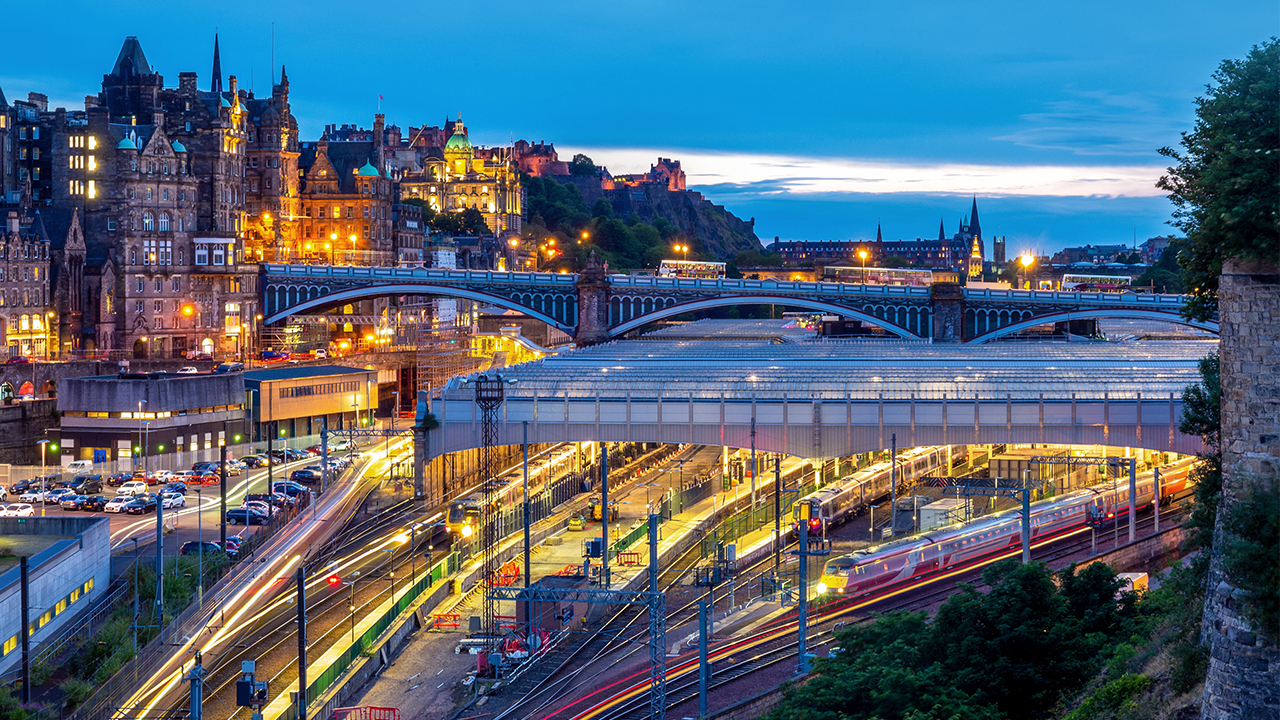04 October 2021, 10:29
Scotland putting rail decarbonisation at heart of net zero plans
First Minister marks completion of Queen Street Station redevelopment
Decarbonising transport, including rail services, offers a significant opportunity to contribute to reducing the threat of climate change, First Minister Nicola Sturgeon has said.
Speaking at a formal launch of the £120m Glasgow Queen Street Station today, the First Minister applauded the substantial investment of over £9bn in rail infrastructure since 2007 that sees over 75% of all rail passenger journeys in Scotland made by electric services.
She also announced key progress in the continuation of rail decarbonisation with confirmation that the £63m Barrhead line electrification will now move to the construction phase. This is the latest milestone in the delivery of Transport Scotland’s Rail Decarbonisation Action Plan, launched last year, which will see removal of all diesel on passenger services by 2035.
The First Minister said:
“With just a month until world leaders arrive in Glasgow to address the growing climate crisis, Scotland’s Railway is on well on track in its journey towards full decarbonisation of passenger services.
“This new Glasgow Queen Street, delivered as part of the Edinburgh Glasgow Improvement Programme, is a shining example of how we can modernise historic and iconic stations, offering greener transport hubs that are more attractive to commuter, business and leisure markets alike.
“This station led the city through industrialisation and it now stands out as an example of what we can achieve as we navigate our way towards net-zero.
“Since 2007, we have invested over £9 billion in rail infrastructure, including electrification to enable greener trains to run on those routes. We are committed to continued electrification, and the use of alternative traction technology, if we are to address the challenges facing this planet. Scotland, as a responsible global citizen, will do everything we can to play our part.”
Alex Hynes, managing director of Scotland’s Railway, said:
“As Scotland continues to recover from the impact of the pandemic, and as Glasgow prepares to host COP26, we are incredibly proud of this new station and the modern, green railway it symbolises.
“The extended and electrified platforms at Glasgow Queen Street help to make sure our railway is ready to play a role in combatting the challenge of climate change and its impact on how we live and work in the future.
“Our engineers, contractors and station teams have worked tirelessly to create a landmark new station for Glasgow and should be commended for completing such a complex job without having to close Queen Street to its passengers.”
Contact Information
Sarah O'Loughlin
Communications Manager
Transport Scotland
0141 272 7198
07920 477564
Sarah.O'[email protected]
Notes to editors
Electrification in Scotland
- Electrification in Scotland increased by twenty-five percent between 2014 and 2019 through the Edinburgh-Glasgow, Stirling-Dunblane-Alloa and Shotts electrification schemes.
- The introduction of ScotRail’s new class-385 electric fleet means f seventy-five percent of their passengers are now travelling on zero emission trains.
- In reality, Scotland’s Railway has been going green for six decades since the electrification of the west coast main line from Glasgow to London and the introduction of electric services to Glasgow’s North Clyde lines in the 1960s and 70s.
- Throughout the decades, the lines to Ayrshire and Inverclyde have been electrified as well as most of the Glasgow suburban network.
- More recently, electrification has been extended up to Stirling and Alloa and between Glasgow and Edinburgh via routes to the north and south of the cities.
- Today, with most trains in Scotland’s Central Belt running under electric power lines, Scotland’s Railway has one of the largest electrified networks outside London.
- Over the next three years, the Barrhead and East Kilbride lines, to the south of Glasgow, will be the latest to see electric trains introduced, and planning is also underway to decarbonise the Borders railway and services in Fife.
- Beyond the Central Belt, the industry is examining a range of options for removing diesel trains from the network and while some form of electrification is the most likely solution for the main lines to Inverness and Aberdeen, elsewhere more innovative options may be employed.
- For the Far North line to Wick and Thruso, the Kyle-of-Lochalsh line and the scenic West Highland lines to Oban and Mallaig, hydrogen or battery powered trains are likely to be the most viable options due to availability of power supplies and the impact on the landscape of overhead power cables.
- The switch to greener forms of traction is not just limited to passenger train operators, freight companies too are finding ways to go green, with more electric freight locomotives and moves into trialling hydrogen, battery-powered and hydro-treated vegetable oil fuelled engines.
- More than 45 percent of freight journeys already run electric in Scotland – and even a diesel freight train is far less polluting than moving goods by road.
- The environmental benefits of rail freight are substantial - a freight train emits just a quarter of the carbon dioxide of the equivalent road journey.
- If just ten percent of Scotland’s HGV movements were switched to rail it would reduce almost as much annual CO2e as the entire rail industry emits. Rail freight has a significant role to play in the decarbonisation of the transport networks in Scotland.”
Queen Street facts and figures
- Originally named Dundas Street Station, Queen Street Station opened in 1842 as the Glasgow terminus of the Edinburgh and Glasgow Railway.
- A major obstacle was the Cowlairs Incline, a steep slope with a gradient of 1 in 46 which required early trains to be hauled from the station by means of a steam-driven winding cable.
- The station was rebuilt and expanded by the North British Railway in 1878-1880 when electric lighting was introduced, one of the earliest examples of the use of electricity in Glasgow. Modernisation of platforms, track and signalling, and of the station forecourt, took place in the late 20th century.
- Queen Street Low Level station, opened in 1886, had to be excavated without disturbing the main line traffic above.
- The Victorian glass roof constructed three decades later and completed in 1878, which is now a category A listed structure.
- The station is Scotland’s third busiest, providing rail connections to and from the city to the wider Glasgow area as well as throughout the country to the east, west and north.
- The station was last re-developed between 1969 and 1973. The modernisation involved the demolition of station buildings dating back to the mid-19th
- At this time an eight-floor office building – Consort House – was constructed along with an extension to the adjoining Millennium Hotel.
Redevelopment facts and figures
- Tonnes of steel used in construction – 1,700T; Tonnes of concrete used in construction – 2,000M3/4800T;
- Hours worked throughout the delivery of the project – approx. 800,000
- Number of people worked across the project over the last four years – approx., 2,500
- Number of people traversed the station during the work – approx. 45m
- Size of concourse - increase from 900m2 to 2002m2
- Projected increase in passenger footfall (pre-Covid) - up 40% by 2030.
- Platforms 2 and 3 extensions involved circa 21,000 hours to remove 2000 tonnes of material and install 100metres of new platform walls, 160metres of new track and connect it to the existing infrastructure, as well as extending the overhead power lines by 50metres
- Station glass frontage comprises 310 glass panes across the 21-metre-high, covering an area of 734m2 and weighing 33,030kg in total.
- Iconic glass fan-shaped gable comprises approx. 700 panes of glass and required 4,000ltr of water to clean.
- New Customer Information System - 12 screens, as opposed to the previous eight and has a 30% lower power requirement than the former screens.
- Cycle provision - 116 parking spaces in total.
- The High Level gateline is a first of its kind for Scotland’s railway. The automatic ticket gates now connect with new over-gate line displays.
- 96 old analogue CCTV cameras replaced with 130 new cameras with a fully IP PoE (Power Over Ethernet) CCTV system. The advantage of PoE technology is that eliminates the need to install AC power outlets - even with multiple IP security cameras to connect, only one source of power is needed, reducing
- The new Public Address Voice Alarm system is linked to the existing Low-Level station to provide passengers with train information and instructions in the event of incidents or emergencies. The system is fully expandable to cater for future development.
- The station has also been cabled with two, 48 Dual Fibre Rings that not only provide resilience against failure, but the capacity for future expansion, both within the station and neighbouring site at North Hanover Street. The fibre cable not only supports ScotRail’s IT, retail and corporate services but provides increased public Wi-Fi for passengers




